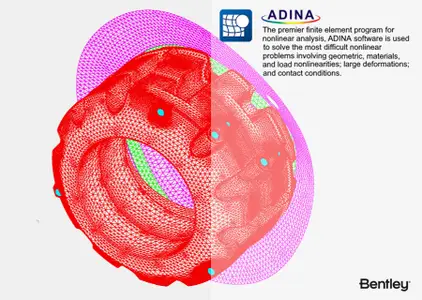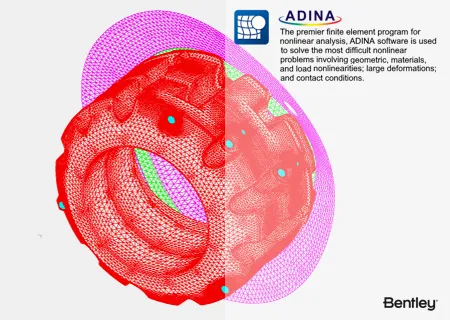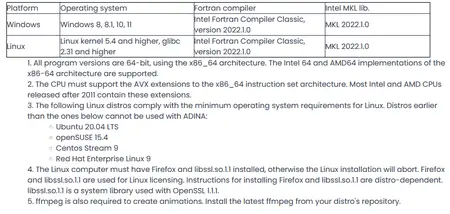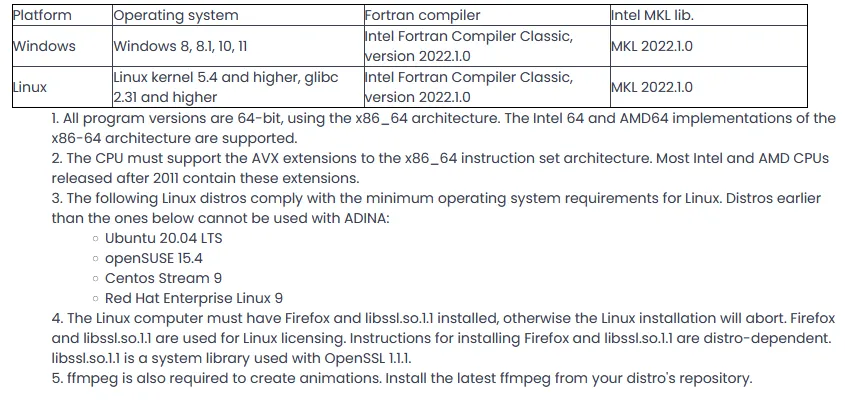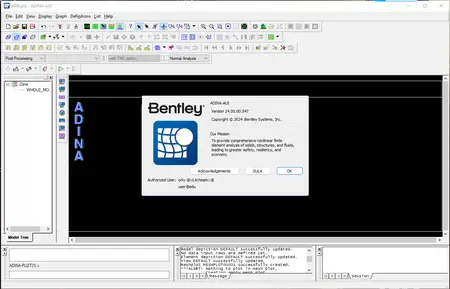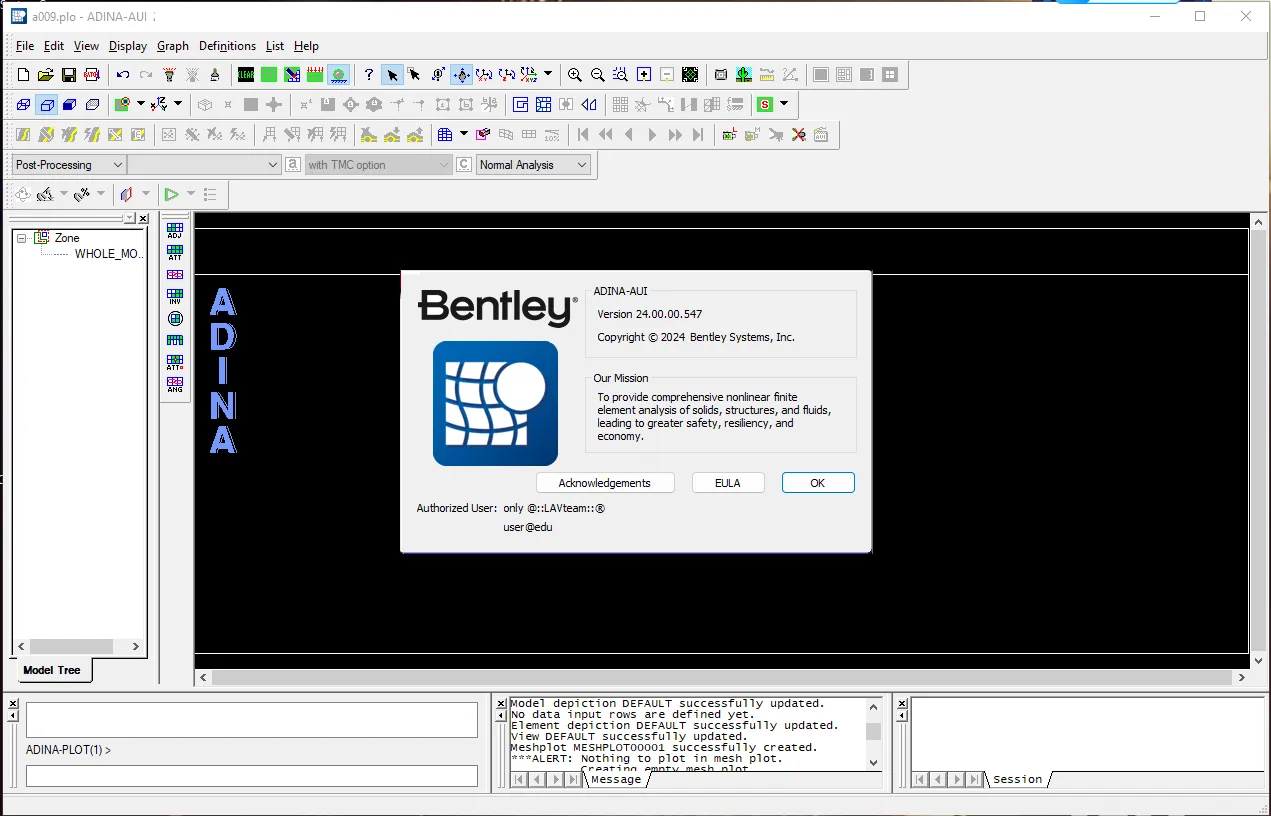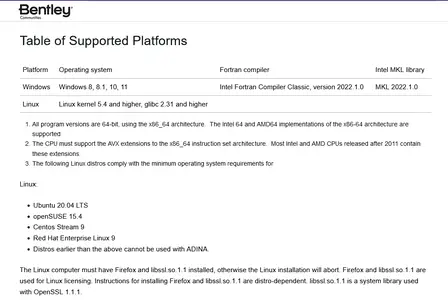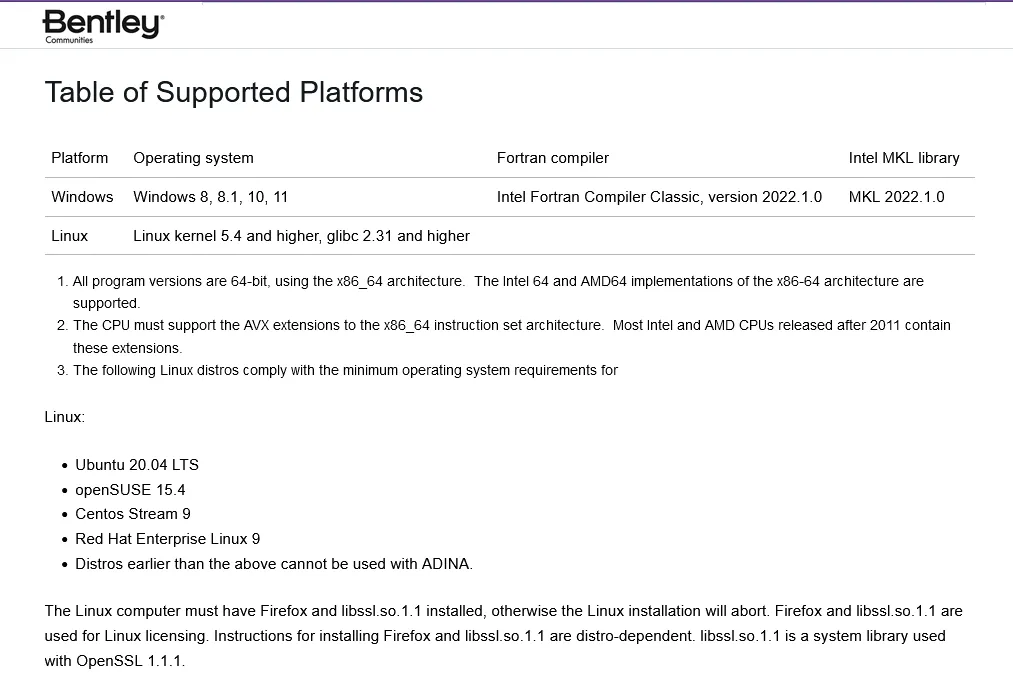ADINA 2024 (24.00.00.547) | 846.8 mb
ADINA R & D Inc., a part Bentley Systems, team is pleased to announce the availability of ADINA 2024 (24.00.00.547) is powerful finite element software, built to help you solve the most difficult nonlinear problems involving geometric, material, and load nonlinearities; large deformations; and contact conditions.
What's new in ADINA 2024 (24.00.00.547) - Release Date: August 2024
New Features
- Results Database
- Link Element
- Shell element with drilling rotation (6 DOF Shell)
- Linux AUI Platform Upgrade
Product Version Naming Convention
Product versioning for Bentley Systems is now based on the calendar year of the major release according to software industry practice. This is the second major ADINA release following the new standard.
Download and Installation Instructions
Installation files for current and past ADINA releases can be downloaded from the Bentley Software Downloads page. After signing-in, the ADINA installers can be located by searching for ADINA. Windows and Linux installers are listed separately.
Notes for all programs and tiers
Changes in licensing
ADINA is still licensed in 3 tiers, ADINA, ADINA Advanced and ADINA Ultimate with an optional ADINA Parasolid Modeler interface that works with any tier.
ADINA 2024 installs the Bentley CONNECTION Client 24.01 for user authentication. This release includes enhanced security by updating to OIDC authentication protocol for
communication with Bentley Cloud Services. It also supports machines configured for FIPScompliant cryptographic module.
The Bentley licensing component for Linux was also updated in this release. This affects the way tokens are encrypted. Linux users who update from version 2023 will be asked for
credentials once, but if the current user has a valid checked-out license and is online, the program will not require the credentials again.
Security advisory
Bentley is committed to continuously investigating and rectifying security vulnerabilities affecting its products and services. Regular checks and security fixes are a part of our releases to ensure better resilience. In this version updates were made to the Bentley Connection Client and License Client as noted above.
Table of supported platforms
New Features
Results Database
ADINA 2024 now outputs some ADINA Structures results to an SQLite database file (called the ResultDB file). Currently it supports implicit static and dynamic analysis results
(including LDC analysis).
The results written to the ResultDB file include:
- Nodal displacements, velocities, accelerations, reactions, temperatures.
- Truss element results, including integration point results and cross-section results.
- Beam element results, including nodal point forces, integration point results (for plastic material models) and cross-section results.
Additional analysis types and analysis results will be added to the ResultDB file in upcoming releases.
For details, see the Command Reference Manual for the command RESULTDB.
Link Element
A new nonlinear link element is available. This element is common for modeling various structural components and intersections such as:
- modeling of braces (such as buckling-restrained-brace) with a nonlinear axial response.
- modeling of foundation soil in which a link element with axial and bending springs is used to capture rocking and translational response of soil.
- modeling of beam end connections in which a zero-length link element (i.e., hinge) is used to capture nonlinear relationship between section moment and rotation at the face of connection (concentrated-plasticity modeling).
- modeling of steel column panel zone area in which nonlinear shear force-deformation response is tracked via link element.
- modeling of coupling beams (i.e., beam connecting wall piers) exhibiting significant shear deformations during seismic events.
The link element is connected to two nodes. If the two nodes coincide, it is called a zero-length element (also known as a hinge element). Otherwise, it is a finite-length element.
The link element supports elastic, nonlinear elastic, and plastic response. Plastic analysis (i.e., the ability to dissipate energy through the cyclic action of elements) is important especially for dynamic analysis of structures subjected to earthquakes.
The link element differs from the spring element, 6DOF spring element, and the connector element in two ways:
- It can utilize all material models available in the truss element. In addition, each material can act independently per material direction.
- It can exhibit general geometric nonlinearity, and up to the nodal DOFs supported by beam.
Shell element with drilling rotation (6 DOF Shell)
A solution that includes shell elements with drilling rotation is attractive for certain problems, such as beam framing into a shell element, applying a twisting moment directly to the shell, or dealing with co-planar shells that lack complete rotational degrees of freedom.
A new 6 DOF Shell element type is now available for 3 and 4 node shells. The 6DOF shell supports in-plane and out-of-plane bending stiffness for general cases and includes Membrane and Bending subtypes. The membrane shell element is suitable for cases where only in-plane forces are considered, such as modeling thin walls in structural applications. Similarly, the bending shell element is commonly used for modeling floor slabs.
Uniaxial and Multiaxial Material Model (Degrading-Plasticity)
The Degrading-Plasticity material model is a uniaxial material model available for truss and link elements. It is also applicable to multiaxial dimensions with three-dimensional solids.
The model exhibits a nonlinear cyclic hysteresis response, bounded by a user-defined backbone curve and it exhibits peak-oriented, pinching or bilinear type of uniaxial response.
This can be used in place of original plastic materials. Similar or improved convergence will be reached, and repeated stress-strain cyclic behaviors will be observed, when compared to original plastic materials in ADINA.
The flow rules and deterioration schemes used in the material combines the concept from soil materials and plasticity, which is newly proposed. This material can be used in modeling of either global or localized behavior of reinforced concrete or composite steel-to-soil structure, in 1D elements or 3D solids with just a single material. For localized effect, the material can be used with large-displacement or finite-strains.
Linux AUI Platform Upgrade
For security reasons, the underlying platform for the Linux ADINA User Interface (AUI) was updated to Qt 6.4.3 Subtle differences in the look of the AUI may result.
Product versioning for Bentley Systems is now based on the calendar year of the major release according to software industry practice. This is the second major ADINA release following the new standard.
Download and Installation Instructions
Installation files for current and past ADINA releases can be downloaded from the Bentley Software Downloads page. After signing-in, the ADINA installers can be located by searching for ADINA. Windows and Linux installers are listed separately.
Notes for all programs and tiers
Changes in licensing
ADINA is still licensed in 3 tiers, ADINA, ADINA Advanced and ADINA Ultimate with an optional ADINA Parasolid Modeler interface that works with any tier.
ADINA 2024 installs the Bentley CONNECTION Client 24.01 for user authentication. This release includes enhanced security by updating to OIDC authentication protocol for
communication with Bentley Cloud Services. It also supports machines configured for FIPScompliant cryptographic module.
The Bentley licensing component for Linux was also updated in this release. This affects the way tokens are encrypted. Linux users who update from version 2023 will be asked for
credentials once, but if the current user has a valid checked-out license and is online, the program will not require the credentials again.
Security advisory
Bentley is committed to continuously investigating and rectifying security vulnerabilities affecting its products and services. Regular checks and security fixes are a part of our releases to ensure better resilience. In this version updates were made to the Bentley Connection Client and License Client as noted above.
Table of supported platforms
New Features
Results Database
ADINA 2024 now outputs some ADINA Structures results to an SQLite database file (called the ResultDB file). Currently it supports implicit static and dynamic analysis results
(including LDC analysis).
The results written to the ResultDB file include:
- Nodal displacements, velocities, accelerations, reactions, temperatures.
- Truss element results, including integration point results and cross-section results.
- Beam element results, including nodal point forces, integration point results (for plastic material models) and cross-section results.
Additional analysis types and analysis results will be added to the ResultDB file in upcoming releases.
For details, see the Command Reference Manual for the command RESULTDB.
Link Element
A new nonlinear link element is available. This element is common for modeling various structural components and intersections such as:
- modeling of braces (such as buckling-restrained-brace) with a nonlinear axial response.
- modeling of foundation soil in which a link element with axial and bending springs is used to capture rocking and translational response of soil.
- modeling of beam end connections in which a zero-length link element (i.e., hinge) is used to capture nonlinear relationship between section moment and rotation at the face of connection (concentrated-plasticity modeling).
- modeling of steel column panel zone area in which nonlinear shear force-deformation response is tracked via link element.
- modeling of coupling beams (i.e., beam connecting wall piers) exhibiting significant shear deformations during seismic events.
The link element is connected to two nodes. If the two nodes coincide, it is called a zero-length element (also known as a hinge element). Otherwise, it is a finite-length element.
The link element supports elastic, nonlinear elastic, and plastic response. Plastic analysis (i.e., the ability to dissipate energy through the cyclic action of elements) is important especially for dynamic analysis of structures subjected to earthquakes.
The link element differs from the spring element, 6DOF spring element, and the connector element in two ways:
- It can utilize all material models available in the truss element. In addition, each material can act independently per material direction.
- It can exhibit general geometric nonlinearity, and up to the nodal DOFs supported by beam.
Shell element with drilling rotation (6 DOF Shell)
A solution that includes shell elements with drilling rotation is attractive for certain problems, such as beam framing into a shell element, applying a twisting moment directly to the shell, or dealing with co-planar shells that lack complete rotational degrees of freedom.
A new 6 DOF Shell element type is now available for 3 and 4 node shells. The 6DOF shell supports in-plane and out-of-plane bending stiffness for general cases and includes Membrane and Bending subtypes. The membrane shell element is suitable for cases where only in-plane forces are considered, such as modeling thin walls in structural applications. Similarly, the bending shell element is commonly used for modeling floor slabs.
Uniaxial and Multiaxial Material Model (Degrading-Plasticity)
The Degrading-Plasticity material model is a uniaxial material model available for truss and link elements. It is also applicable to multiaxial dimensions with three-dimensional solids.
The model exhibits a nonlinear cyclic hysteresis response, bounded by a user-defined backbone curve and it exhibits peak-oriented, pinching or bilinear type of uniaxial response.
This can be used in place of original plastic materials. Similar or improved convergence will be reached, and repeated stress-strain cyclic behaviors will be observed, when compared to original plastic materials in ADINA.
The flow rules and deterioration schemes used in the material combines the concept from soil materials and plasticity, which is newly proposed. This material can be used in modeling of either global or localized behavior of reinforced concrete or composite steel-to-soil structure, in 1D elements or 3D solids with just a single material. For localized effect, the material can be used with large-displacement or finite-strains.
Linux AUI Platform Upgrade
For security reasons, the underlying platform for the Linux ADINA User Interface (AUI) was updated to Qt 6.4.3 Subtle differences in the look of the AUI may result.
Civil, structural, and mechanical engineers choose ADINA software for its authoritative veracity, including in analysis of buildings, bridges, stadiums, pressure vessels, dams, and tunnels. By virtue of the ADINA System’s integral robustness across disciplines, materials, and simulation domains (structures, mechanical, fluids, thermal, electromagnetic, and multi-physics), engineers use it to perform comprehensive safety and performance studies where reliability and resilience are of critical importance. With infrastructure digital twins, users can simulate the complete behavior of structures to create confidence in designs that are much safer and more cost-effective than those merely analyzed to meet prescribed code standards. Of particular importance for infrastructure resilience, ADINA will also be applied within digital twins of existing infrastructure assets, now made practical by the Bentley iTwin platform, to simulate their responses and vulnerabilities to stresses so extreme that nonlinear effects must be considered—caused (for instance) by seismic, wind, flood, pressure, thermal, collision, or blast forces. The ADINA System’s nonlinear simulation capabilities will in turn become directly accessible, through convenient technical and commercial integration, to users of Bentley Systems’ uniquely comprehensive modeling and simulation software portfolio for infrastructure engineering. As the ADINA System’s nonlinear extensions are introduced to complement these existing physical simulation applications—currently spanning STAAD, RAM, SACS, MOSES, AutoPIPE, PLAXIS, LEAP, RM, LARS, SPIDA, and PLS—the scope of mainstream simulation underlying the engineering of infrastructure resilience will be valuably enhanced. ADINA’s advantages also include advanced dynamics, 3D solid FEM, buckling, substructuring, and advanced meshing for critical joints and sections.
Bentley Leverages ADINA for Structural Engineering
Recently, Seth Guthrie, Director of Structural Product Management, spoke with Informed Infrastructure podcast host Todd Danielson. Seth shared how leveraging the analytical power of ADINA software can help you perform more flexible analysis of your nonlinear systems.
The development of ADINA was started, and the foundation established, by Dr. K.J. Bathe in 1974. Soon thereafter, in 1975, Dr. K.J. Bathe joined the Department of Mechanical Engineering at the Massachusetts Institute of Technology. In 1986, he founded ADINA R&D, Inc. for fostering the development of the ADINA system. He is a leading world-renowned researcher in the field of finite element analysis who has authored several textbooks and numerous journal papers. Dr. Bathe leads the development of the ADINA system.
Bentley Systems is the infrastructure engineering software company. We provide innovative software to advance the world’s infrastructure – sustaining both the global economy and environment.
Bentley Systems recently announced the acquisition of ADINA R&D, Inc., developer of finite element analysis software applications. The addition of ADINA's technology to Bentley's software applications will further strengthen Bentley's structural software offerings. Users will gain even greater confidence in their structural software designs.
Owner: ADINA R&D, Inc.
Product Name: ADINA
Version: 2024 (24.00.00.547)
Supported Architectures: x64
Website Home Page : www.bentley.com
Languages Supported: english
System Requirements: Windows *
Size: 846.8 mb
Please visit my blog
Added by 3% of the overall size of the archive of information for the restoration
No mirrors please
Added by 3% of the overall size of the archive of information for the restoration
No mirrors please


